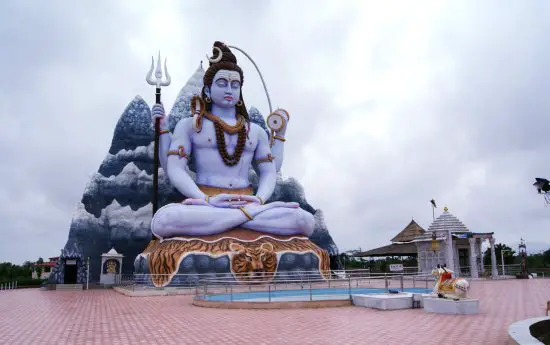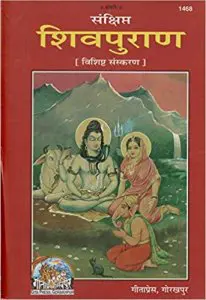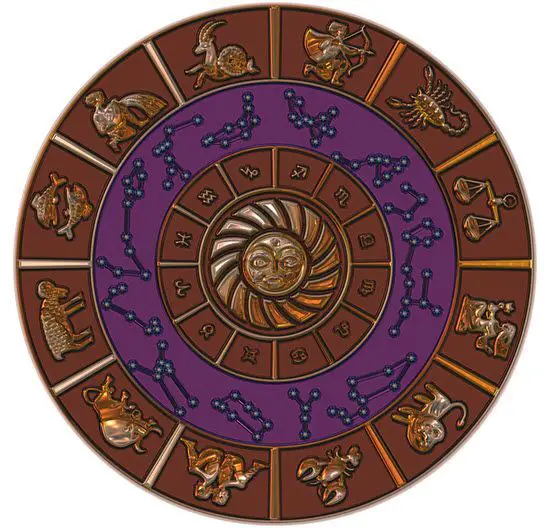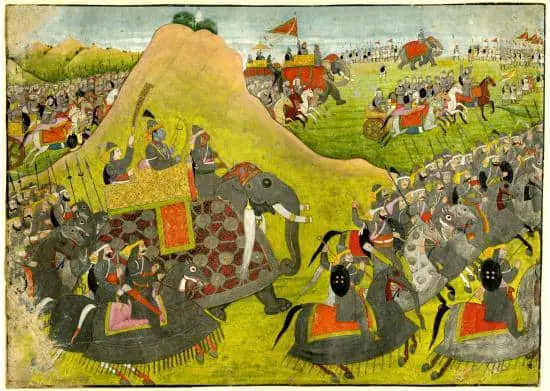The Shiva Purana is a very famous Hindu religious text belonging to the Purana genre of Sanskrit Texts in Hinduism. It is an integral part of the Shaivism literature corpus. The Shiva Purana is primarily dedicated to Lord Shiva and Goddess Parvati. However, it also references and reveres all gods. This post shares with you details about Shiva Purana.
The original manuscript of Shiva Purana consisted of 100,000 verses that were set out in twelve Samhitas (books). It has been written by Romaharshana, who was the disciple of Sage Vyasa, belonging to the Suta class.
Its surviving manuscripts have been found in many different versions and content. For example, one major version has seven books; another version has six books, and the third version is traced to the medieval Bengal region of the Indian Subcontinent that has two large sections, namely the “Purva-Khanda” and the “Uttara Khanda.”
However, like other Puranas, Shiva Purana also existed as a living text that was occasionally edited, recast, as well as revised over a long period. It is estimated that the oldest manuscript of surviving texts had been likely composed around 10th to 11th century CE. Some of its chapters were likely composed after the 14th century.
The Shiva Purana contains several chapters that are centered on Shiva cosmology, mythology, and relationship with Gods, Yoga, Ethics, Pilgrimage Sites, Bhakti, Rivers, as well as Geography and other topics.
The Shiva Purana also throws significant insights on Advaita Vedanta philosophy. The text proves an important source of historical information on the theology behind Shaivism around 2nd-millennium CE.
Table of Contents
Who is Shiva?
Shiva, who is also called Mahadeva or Bholenath, is one of the main deities of Hinduism. Shiva is considered as the “Destroyer” within the Trimurti that includes Brahma and Vishnu. According to the Shaivism tradition, Shiva is considered to be one of the supreme beings who creates, protects, as well as transforms the Universe.

In fact, Hindu scriptures have both benevolent and fearsome depictions of Lord Shiva.
As far as his benevolent aspects are concerned, Shiva has been described as an omniscient Yogi who leads the life of an ascetic on Mount Kailash.
He is also depicted as a householder having Parvati as his wife, and Ganesh and Kartikeya as his two children. However, in his fierce aspects, Shiva is portrayed as slaying the demons. Shiva is also known as “Adiyogi” and is regarded as the patron God of yoga, meditation, and arts.
Shiva is shown with a serpent around his neck. He adorns the crescent Moon, and the holy Ganga River flows from his matted hair. He adorns the third eye on his forehead and holds the Trishul or Trident as his weapon. He also holds the Damuru drum. He is usually worshipped in the iconic form of Shiva “Lingam.”
The Hindus call Shiva as “Parabhrahman” which means nothingness. Shiva is portrayed to be omnipresent, omnipotent, and even present in the form of one’s consciousness. In his Nataraja form, Shiva is worshipped in a human figure format. However, he is usually worshipped in the Lingam figure.
The Sanskrit word, Shiva, means auspicious, gracious, kind, benevolent, and friendly. Here, the root word “Si” means “in whom all things lay” and “Va” signifies “embodiment of grace.” The Vedas portray Shiva as Rudra who is the auspicious one and liberates the soul from the bondage of life and death.
Shiva is known by numerous names such as Vishwanath, Mahadeva, Maheshwar, Shankara, Shambu, Rudra, Neelakantha, Trilokinatha, Hara, Devendra, and Ghrneshwar (lord of compassion).
You may like Lord Shiva Mantras
Who wrote Shiva Purana?
The Shiva Purana was written by Romaharshana, who was the disciple of Sage Vyasa, belonging to Suta class.
What is Shivling, according to Shiv Puran?
A Shiva Lingam is an abstract or aniconic representation of Lord Shiva. It is a simple cylinder that is set inside a yoni and placed within a disc-shaped platform. It is regarded as a form of spiritual iconography.
As per the Shiva Purana, the Shiva Lingam has been described as the beginning-less and endless cosmic pillar of fire. It is the cause of all causes. Lord Shiva is shown as emerging from the lingam in the form of a cosmic pillar of fire that proves his superiority over other gods such as Brahma and Vishnu.
So, the Shiva Lingam symbolizes the infinite nature of Shiva.
Famous Stories from Shiva Purana
Here, we narrate one of the most famous stories in Shiva Purana. This story goes as follows:
Once, Lord Vishnu was having a nap on the serpent king Sheshanaga. Goddess Lakshmi was serving him along with his attendants. It so happened that Lord Brahma came to see him. He went angry with Lord Vishnu as the later did not get up and saluted him. He argued with Lord Vishnu and said that He was the protector of the world.
However, Lord Vishnu told Brahma that the whole universe is situated within him. He told Brahma that he had emerged from the navel seated in the lotus. So, Brahma was his son.
They continued to argue with each other, and finally, they were ready to fight. Lord Brahma sat on his Swan, and Lord Vishnu sat on his Garuda and started to fight with each other.
It was a terrible fight as both showered deadly weapons on each other. All the Devas witnessed the terrible fight and decided to approach Lord Shiva to end this terrible war between Brahma and Vishnu.
So, they went to Kailash, the abode of Lord Shiva. There they saw Lord Shiva sitting in the company of Goddess Uma. All the Devas bowed down before Lord Shiva.
Now, Lord Shiva told the Devas that he already knew about the fight between Brahma and Vishnu. Lord Shiva reached the battlefield where the terrible war was going on. He assumed the form of huge column fire and stood in between them. This column of fire had neither beginning nor any end. So, Brahma and Vishnu decided to find its beginning and end.
Lord Vishnu attained the form of a Boar and headed downwards to find the end of the column of fire. However, Lord Brahma attained the form of a Swan and headed upwards in search of the end of the column of fire.
Now, Lord Vishnu was not able to find the root of the column and returned to the battleground. However, Brahma went on flying to prove his supremacy.
Lord Shiva laughed to see this struggle of Brahma, and the Ketaki flower fell from his head. Then Brahma asked Ketaki to lie for him that he had found the end of the fire column.
Now, Brahma went down and told Vishnu that he had found the beginning of the column of fire. Ketaki gave its proof. Then, Vishnu nodded before Brahma and said to him, “Oh! Brahma, you are greater than me.”
This made Lord Shiva turn red with anger. He came to his real form and scolded Brahma that he was lying as there was no beginning to this column.
He opened his third eye, and a ferocious being emerged from it. He was Kala Bhairava, who chopped the Brahma’s head. Now, Lord Shiva told Brahma that no one would worship him as he had lied before Vishnu.
Lord Shiva told Vishnu that as he had followed the path of truth, he would be worshipped as “Satya Narayan,” and your devotees would perform Satya Narayan Puja on Poornima.
Now, Lord Shiva returned to his abode Kailash.
Here, we narrate another interesting story from Shiva Purana. This story describes the birth of Mangal (Mars), Graha.
According to the Shiva Purana, Mangal was born out of Lord Shiva’s sweatdrop. It so happened that after the death of Sati, Lord Shiva went into the state of deep Samadhi. When he opened his eyes, his sweatdrop fell down.
His sweat drop took the form of a child and started to cry. The mother earth took the form of a woman and held the child in his hands and calmed him down.
Now, Lord Shiva told Goddess Earth that this red colored baby would be called Mangal, and you would have to bear the role of his mother.
He will always be near your position in the solar system. So, our ancient Rishis knew much about the solar system. Now, it is scientifically proven that Mars is a red-colored planet and is near to the earth.
Signs of death according to Shiv Puran
Shiva Purana describes eleven signs that indicate the death of a person. Lord Shiva told Goddess Parvati about the following signs of death:
- A person cannot see his or her shadow if one month is left in a death
- If the tongue of a person gets swollen suddenly and teeth are filled with puss, then it means that death is very close
- If the tongue, mouth, ear, eyes, and nose become hard like a stone, then it means that the person has a month only to leave this world
- If a person is not able to see any color except black color, then it means that death will happen very soon
- If a person begins to see the sun, moon, and sky as red, then it means that death is very close
- When a person dreams of an owl, then it indicates that death is very near
- If a person left-hand goes on twitching, then it signals that death is very near
- If a person is not able to locate the Dhruva star in the sky, then it means that the person will die within six months maximum
- If a person is not able to view his or her reflection in the water, mirror, and oil, then it means that death is going to happen soon
- If a person gets suddenly surrounded by blue flies, then it means that he or she will die within a month
- If a crow, vulture, or pigeon sits on someone’s head, then it means that death is near
- If the color of a person turns into pale yellow, then it is indicative that death will occur shortly
- When a person is not able to see the light of the sun, moon, stars, and fire, then it means that the person will die within six months
12 Jyotirlinga according to Shiva Purana
The 12 Jyotirlinga, according to Shiva Purana, are as follows:
- Kedarnath in the Himalayas
- Bhima Shankar in Dakinya
- Viswesvara in Varanasi
- Triambakeshwar on the banks of River Gautami
- Somnath in Saurashtra
- Mallikarjuna in Sri Sailam
- Mahakaal in Ujjain
- Amareswara at Omkara
- Vaidyanath in Chitha Bhumi
- Nagesa at Daruka
- Rameshwara in Setu Bandhanan
- Ghrishneswara
Can anyone read Shiva Purana at home?
Not only Shiva Purana but also all other Puranas as well are sacred religious texts of Hinduism. So, you can certainly keep any of the Hindu Purana literature (including Shiva Purana) at home as they are pure and pious religious documents of life at large.
The Shiva Purana is a holy religious text that should not only be kept at home but read and understood well. It goes on to enhance your understanding of life. All these religious texts, including Shiva Purana, tell the truth of life, which may not be sweet to you. So, you should be prepared to face the truth.
The Shiva Purana should be placed in a clean, neat, and sanctified place in your home. You should read them slowly so that you can digest their sayings. It will help to resolve you as a person.
So, now you should have got clarity on the subject of whether you should read Shiva Purana at home.
Shiva Purana Book
The Shiva Purana Book is available in Kindle Edition. Many other publishers have also come up with numerous editions of Shiva Purana. For example, Geetapress Gorakhpur has come up with Hardcover Shiva Purana in four volumes. It is cheaply priced and available at all leading online stores such as Amazon.

With this, we have come to the end of this post on Shiva Purana. We hope that you have found this article useful and interesting. Thanks for visiting. We welcome your comments and suggestions. Please share the post across major social networking channels.




